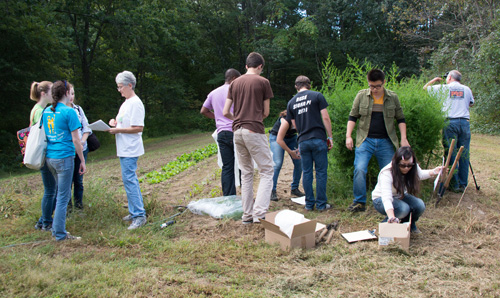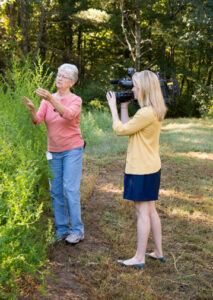
January 3, 2014
By Robert Cooke, Science Journalist
Continuing experiments with a weedy plant grown here in Stow are showing unexpected and encouraging signs of progress in the global battle against malaria.
According to biologist Pam Weathers — a Stow resident and faculty member at the Worcester Polytechnic Institute — foliage samples of Artemisia annua, when dried and pulverized, are showing promising signs of efficacy in animals here, and in human subjects in Africa. The human clinical studies are being done by African scientists in nations such as Kenya.
In the experiments done here, Weathers said, “We’ve found what we should do, and what we shouldn’t do, in terms of making the most of this” potential anti-malaria treatment. Using dried and powdered artemisia foliage samples grown by Dwight Sipler here in Stow, the WPI team is assessing various dosage levels while monitoring for toxic side effects in their laboratory mice.
In some African experiments, the research teams also make a tea-like beverage from the artemisia plants and give it to malaria patients. African researchers also extract and purify various chemicals from the plant tissues. Still other experimenters grind up the dried leaves, squeeze the dried powder into pills, and then give the pills directly to malaria patients.
“So far, the powdered plant materials seem to work best, and apparently cause no toxic side effects. “At the highest doses,” Weathers added, there seemed to be about a 90 percent cure rate for people infected with the malaria parasite. Still, “about 10 percent of the patients saw a return of malaria symptoms. And we don’t know whether these were new infections” from subsequent mosquito bites, or were the existing infections re-emerging, she said.”
Although it is encouraging that so many patients (and mice) seemed to be cured by artemisia treatment, Weathers emphasized that these experiments were not rigorous, tightly-controlled, double-blind clinical trials. So these results must be considered preliminary, with much more work still to be done in both the laboratory and the field. That means artemisia treatments are not ready for prime time.
The recent local studies were done with two artemisia crops grown here in Stow by Sipler at the “Small Farm” agricultural plot on Route 62 run by he and his wife, Barbara. Sipler said this second experiment, in 2013, involved growing some of the plants at different densities in the field to learn if more or less sunlight alters how vigorously the plants grow.
“This year, we grew fewer plants per acre,” Sipler said, “to get some idea about the best plant- spacing in terms of yield. Last year it was 12 plants per square meter. This year it was 8 plants per square meter.”
Also, unlike last year, Sipler said he didn’t apply fertilizer, and he also didn’t irrigate the 2013 experimental crop. Those two changes didn’t seem to make much difference. The weather was relatively benign for both the 2012 and 2013 crops.
Weathers added that the artemisia research here is being supported in part by the U.S. Department of Agriculture, which has a long-standing interest in promoting agricultural progress. Despite the rising enthusiasm about this potential malaria treatment, Weathers noted that the World Health Organization doesn’t yet share the excitement about using artemisia powder as a solo treatment for malaria.
WHO experts insist that other drugs should also be used in combination with the various forms of artemisia to keep the parasite, Plasmodium falciparum, from developing drug resistance. Weathers agrees that drug resistance is a real danger, but also argues that the weed she’s working with also has some major advantages. First, it is cheap. Second, it seems to be effective. And third, it can probably be grown as a cash crop in remote, less- developed parts of Africa, where a cure of some kind is needed most.

(Dwight Sipler photo)
Also, those very remote and undeveloped parts of Africa are where the far more expensive drugs being developed would likely be unavailable, especially if new drugs are costly, delicate, hard to administer, and need special handling such as refrigeration. Also, major international efforts to provide insecticide- treated bed nets to protect against night-biting mosquitos don’t always reach people in very remote parts of Africa, and elsewhere.
There is no doubt, of course about the dire human impact of malaria. Many millions of people are infected every year, mostly in Africa, Asia and Latin America. And the result is widespread sickness and death year after year, plus major economic impact.
Outside of Africa, malaria is caused by other known species of malaria, all transmitted by the bites of the mosquitoes that are endemic in tropical areas. In the past, attempts to defeat mosquito-borne diseases – also including dengue and yellow fever – focused on intense, large-scale applications of insecticides, especially DDT, after World War II. But, in response, the blood-sucking bugs gradually developed resistance to the insecticides, allowing mosquito populations to rebound, and the diseases rebounded with them.
In addition to perhaps offering a potent new weapon for combating a difficult global disease, it’s also been suggested that the research being done here with artemisia may also lead to a useful and profitable alternative new crop for New England farmers. It could eventually become another source of agricultural income, beyond the existing orchards and dairies.
The artemisia plant, native to China, is related to sagebrush and wormwood. It has long been a favorite herbal ingredient in Asian folk medicine. In North America, it is usually considered just a smelly weed.
The local experiments on mice conducted by Weathers, Sipler and their colleagues helped verify that feeding dried, powdered leaves of artemisia results in 40 times more of the active ingredient, called artemisin, getting into the bloodstream, compared to the other drug preparations, such as artemisia tea. The accumulating results were published in the scientific journal Phytochemistry Review.